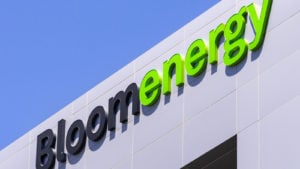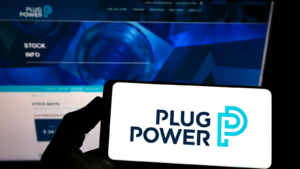So for people to find the best hydrogen stocks to buy, I’ve assembled a list of three companies to consider. Some of these names are risky plays, while others involve less speculation. But either way, I feel that the buzz that surrounds these names is grounded in reality. They deserve special attention from investors.
So here are three hydrogen stocks that investors should consider buying in March for this year.
Bloom Energy (BE)

Bloom Energy (NYSE:BE) operates in the clean energy sector, focusing on producing and deploying fuel cell systems that generate electricity.
In 2023, Bloom Energy reported significant growth, achieving a record revenue of over $1.33 billion for the full year. That marks an 11% increase from the previous year. The company also reported a strong Q4 revenue of $357 million and has a substantial backlog exceeding $12 billion, up 21% from the end of 2022.
For 2024, Bloom Energy anticipates revenue of $1.4 billion to $1.6 billion. Non-GAAP operating profit is projected between $75 million to $100 million. The company is focusing on expanding into additional international markets following its success in Korea.
Adding to this is that the stock has a price target of $16.47, indicating an 81.39% upside, with an analyst consensus rating of “Buy” from analysts.
I think that BE stock could be one of the best names in the market. Some of Wall Street’s best analysts agree with this sentiment, too. It’s then one of those hydrogen stocks to consider.
Plug Power (PLUG)

Plug Power (NASDAQ:PLUG) operates in hydrogen fuel cell technology space, offering solutions that power electric motors primarily for the logistics.
This hydrogen stock is my contrarian pick for investors who can take high risks in the hydrogen market. There have been concerns raised before about the company’s ability to remain a going concern. Those are mostly due to concerns raised about its liquidity levels and rate of cash burn. However, it now states that the issue has been “resolved”.
In FY2023, the company’s revenue increased by 27% from the previous year, reaching $891.34 million. However, it also faced a significant loss of $1.37 billion, an increase of 89.1% from 2022.
Looking ahead, the company has not specified explicit guidance but continues investing in its hydrogen infrastructure. It’s focused on expanding its green hydrogen network in the U.S. and Europe. Plug Power is eyeing $6 billion in revenue by 2027.
I’ve remained bullish on PLUG since it was handwaved by analysts on Wall Street due to fears around its solvency. I still think it’s one of the strongest picks for high-risk investors today. Its price-to-sales ratio is just 2.9 times sales at the time of writing.
Ballard Power Systems (BLDP)

Ballard Power Systems (NASDAQ:BLDP) specializes in proton exchange membrane fuel cell technology. This gives it a strong specialization that differs from other hydrogen stocks that are vying for a larger market share.
In Q3 2023, BLDP saw a 29% year-over-year increase in total revenue, reaching $27.6 million. This increase was driven primarily by higher revenues from the rail and marine verticals. There were, however, lower revenues in the bus and truck segments.
For the future, it will be taking advantage of its 177 hydrogen fuel cell engines from Solaris Bus & Coach, a leading European bus manufacturer. These orders include the supply of fuel cell engines for what is described as the largest announced deployment of a fleet of fuel cell city buses in Europe.
I think that BLDP is one of those stocks that investors should keep on their radar. It has just $18 million in total debt and plenty of cash on its balance sheet relative to its cash burn rate to help drive it toward profitability.
On the date of publication, Matthew Farley did not have (either directly or indirectly) any positions in the securities mentioned in this article. The opinions expressed are those of the writer, subject to the InvestorPlace.com Publishing Guidelines.
Matthew started writing coverage of the financial markets during the crypto boom of 2017 and was also a team member of several fintech startups. He then started writing about Australian and U.S. equities for various publications. His work has appeared in MarketBeat, FXStreet, Cryptoslate, Seeking Alpha, and the New Scientist magazine, among others.
